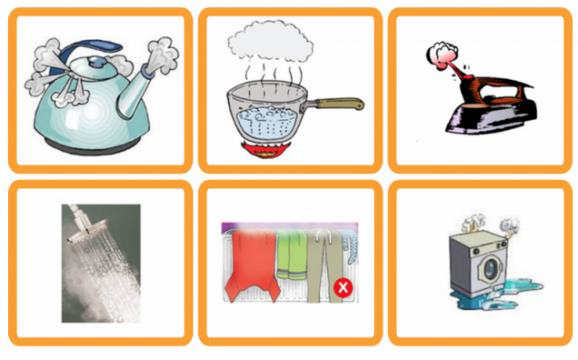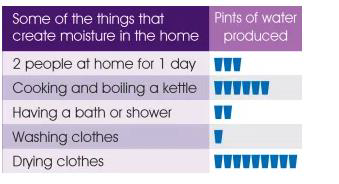

There is always moisture in the air, but when additional moisture is created by cooking, taking baths or showers or drying clothes indoors this can create an excessive build-up of moisture which can lead to condensation. Condensation can be more of a problem in the cold winter months, where it is often found next to windows, in the corners of rooms and behind wardrobes. Over time this can cause black mould and damp patches to appear.
1. Reduce the moisture in your home.

• Avoid creating a lot of steam in the kitchen – cover pans and don’t leave the kettle boiling. If fitted, use an extractor fan when cooking or bathing and for at least 30
minutes afterwards.
• Shut the bathroom door when bathing or showering.
• If you are running a bath, put some cold water in first to reduce the amount of steam.
• Dry clothes outside whenever possible.
• If you do not have an outdoor space to line dry your clothes (or the weather is bad), only dry clothes in the bathroom with the door closed and windows open or extractor
fan on. Hang clothes so that the air has free circulation around each item to allow
quicker drying.
• Do not place washing directly on top of your radiators unless it is a towel rail purposefully
designed for drying.
• Keep a window or trickle vents slightly open when you’re using a room.
• Move furniture away from walls to allow air to circulate behind it.
• Air cupboards and wardrobes and avoid putting too much in them as this stops the air circulating.
• In cold weather, consider keeping your whole property at a constant temperature, so unused rooms don’t become refrigerators for the rest of the property.
• If you have a thermostatic control on radiators, set the temperature on low in unused rooms so that the heating kicks in when it goes below 10°.
• Warm walls and an even temperature reduce the likelihood of condensation and damp.
• Any condensation that forms on surfaces should be wiped off promptly to prevent the risk
of damp and mould.
• If mould still appears in your home, wipe it with a fungicidal wash – you can buy this in most large supermarkets or DIY stores.
• Alternatively, you can use a very weak bleach solution.
• Please make sure you wear rubber gloves and follow the manufacturer’s guidelines.